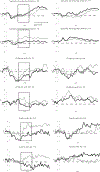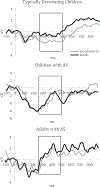Typical and atypical neural mechanisms support spoken word processing in Angelman syndrome
- PMID: 36502770
- PMCID: PMC9839587
- DOI: 10.1016/j.bandl.2022.105215
Typical and atypical neural mechanisms support spoken word processing in Angelman syndrome
Abstract
Angelman syndrome (AS) is known to affect expressive and receptive communication abilities. This study examined individual differences in neural mechanisms underlying speech processing in children with AS (n = 24, M age = 10.01 years) and typical development (n = 30, M age = 10.82 years) using auditory event-related potentials during passive listening to common English words and novel pseudowords. A group of adults with AS (n = 7, M = 31.78 years) provided data about the upper developmental range. The typically developing group demonstrated the expected more negative amplitudes in response to words than pseudowords within 250-500 ms after stimulus onset at the left temporal scalp region. Children and adults with AS exhibited a similar left-lateralized pattern of word-pseudoword differentiation at temporal and parietal regions, but not the midline parietal memory response for known words observed in the typically developing group, suggesting typical-like word-pseudoword differentiation along with possible alterations in the automatic recall of word meaning. These results have important implications for understanding receptive and expressive communication processes in AS and support the use of auditory neural responses for characterizing individual differences in neurodevelopmental disorders with limited speech.
Keywords: Angelman syndrome; Auditory; ERP; Receptive; Speech; Word.
Copyright © 2022 Elsevier Inc. All rights reserved.
Conflict of interest statement
Declaration of Competing Interest The authors declare that they have no known competing financial interests or personal relationships that could have appeared to influence the work reported in this paper.
Figures



References
-
- Aman MG, & Singh NN (1986). Aberrant Behavior Checklist. East Aurora, NY: Slosson.
-
- Andersen WH, Rasmussen RK, & Strømme P (2001). Levels of cognitive and linguistic development in Angelman syndrome: a study of 20 children. Logopedics Phoniatrics Vocology, 26(1), 2–9. - PubMed
-
- Buckley RH, Dinno N, & Weber P (1998). Angelman syndrome: are the estimates too low? American Journal of Medical Genetics, 80(4), 385–390. - PubMed
Publication types
MeSH terms
Grants and funding
LinkOut - more resources
Full Text Sources
Research Materials

